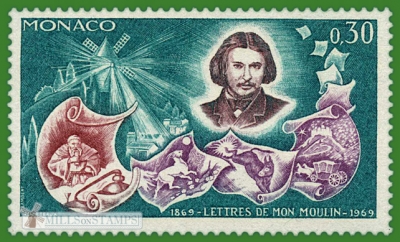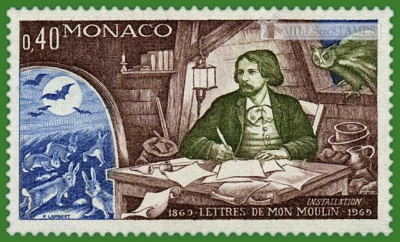-
Centenary of First publication of “Letters from My Windmill,” by Alphonse Daudet
Monaco 1969.11.25
In issue: Stamp(s): 5
Printing: engravings
Issued in: sheets of 30 (5*6) stamps
-
Number by catalogue: Michel: 941 Yvert: 792 Scott: 743
Perforation type: 13 ½x13
Subject:
30 centimes. Alphonse Daudet and Scenes from “Letters from My Windmill”*
Topics: Alphonse Daudet Mills in Art Windmills
-
Number by catalogue: Michel: 942 Yvert: 793 Scott: 744
Perforation type: 13 ½x13
Subject:
40 centimes. Alfons Daudet at work at his windmill
Additional:
*Alphonse Daudet (13 May 1840 – 16 December 1897) was a French novelist.
Alphonse Daudet was born in Nîmes, France. His family, on both sides, belonged to the bourgeoisie. The father, Vincent Daudet, was a silk manufacturer — a man dogged through life by misfortune and failure. Alphonse, amid much truancy, had a depressing boyhood. In 1856 he left Lyon, where his schooldays had been mainly spent, and began life as a schoolteacher at Alès, Gard, in the south of France.
On 1 November 1857, he abandoned teaching and took refuge with his brother Ernest Daudet, only some three years his senior, who was trying, "and thereto soberly," to make a living as a journalist in Paris. Alphonse took to writing, and his poems were collected into a small volume, Les Amoureuses (1858), which met with a fair reception. He obtained employment on Le Figaro, then under Cartier de Villemessant's energetic editorship, wrote two or three plays, and began to be recognized, among those interested in literature, as possessing individuality and promise. Morny, Napoleon III's all-powerful minister, appointed him to be one of his secretaries — a post which he held till Morny's death in 1865 — and showed Daudet no small kindness. Daudet had put his foot on the road to fortune.
In 1866, Daudet's Lettres de mon moulin, written in Clamart, near Paris, and alluding to a windmill in Fontvieille, Provence, won the attention of many readers. The first of his longer books, Le petit chose (1868), did not, however, produce popular sensation. It is, in the main, the story of his own earlier years told with much grace and pathos. The year 1872 brought the famous Aventures prodigieuses de Tartarin de Tarascon, and the three-act play L'Arlésienne. But Fromont jeune et Risler aîné (1874) at once took the world by storm. It struck a note, not new certainly in English literature, but comparatively new in French. His creativeness resulted in characters that were real and also typical.
Jack, a novel about an illegitimate child, a martyr to his mother's selfishness, which followed in 1876, served only to deepen the same impression. Henceforward his career was that of a successful man of letters, mainly spent writing novels: Le Nabab (1877), Les Rois en exil (1879), Numa Roumestan (1881), Sapho (1884), L'Immortel (1888), and writing for the stage: reminiscing in Trente ans de Paris (1887) and Souvenirs d'un homme de lettres (1888). These, with the three Tartarins, Tartarin de Tarascon, Tartarin sur les Alpes, Port-Tarascon, and the short stories, written for the most part before he had acquired fame and fortune, constitute his life work.
L'Immortel is a bitter attack on the Académie française, to which august body Daudet never belonged.Daudet wrote some stories for children, including "La Belle Nivernaise," the story of an old boat and her crew.
In 1867 Daudet married Julia Allard, author of Impressions de nature et d'art (1879), L'Enfance d'une Parisienne (1883), and some literary studies written under the pseudonym "Karl Steen."
Daudet was far from faithful, and was one of a generation of French literary syphilitics. Having lost his virginity at age twelve, he then slept with his friend's mistresses throughout his marriage. Daudet would undergo several painful treatments and operations for his subsequently paralyzing disease. His journal entries relating to the pain he experienced from tabes dorsalis are collected in the volume In the Land of Pain, translated by Julian Barnes.
Daudet died in Paris on 16 December 1897, and was interred at that city's Père Lachaise Cemetery.**Letters from My Windmill (French: Lettres de mon moulin) is a collection of short stories by Alphonse Daudet first published in its entirety in 1869. Some of the stories had been published earlier in newspapers or journals such as Le Figaro and L'Evénement as early as 1865.
The stories are all told by the author in the first person, typically addressing a Parisian reader. The author, having relocated his home from Paris, recounts short bucolic tales about his new life in Provence as well as his trips to Corsica and French Algeria. Considered to be light-hearted, and often a bit tongue-in-cheek, the stories vary from day-to-day events in southern France to Provençal folk-tales, and often feature professions and faunal references characteristic of Provence.
Letters From My Windmill is sometimes considered to be Daudet's most important work. It is cherished by many French, particularly in the South, for the picture it paints of the local culture.__________
This information has been taken from Wikipedia
Topics: Alphonse Daudet Windmills




